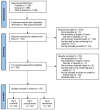Systematic Review and Meta-Analysis of Mercury Exposure among Populations and Environments in Contact with Electronic Waste
- PMID: 36231146
- PMCID: PMC9564538
- DOI: 10.3390/ijerph191911843
Systematic Review and Meta-Analysis of Mercury Exposure among Populations and Environments in Contact with Electronic Waste
Abstract
Electronic waste (e-waste) recycling releases mercury (Hg) into the environment, though to our knowledge Hg levels at such sites have yet to be examined on a worldwide basis. A systematic review of scientific studies was conducted to extract, analyze, and synthesize data on Hg levels in e-waste products, environments near recycling sites, and in people. Data were extracted from 78 studies from 20 countries, and these included Hg levels in 1103 electrical and electronic products, 2072 environmental samples (soil, air, plant, food, water, dust), and 2330 human biomarkers (blood, hair, urine). The average Hg level in products was 0.65 μg/g, with the highest levels found in lamps (578 μg/g). Average soil and sediment Hg levels (1.86 μg/g) at e-waste sites were at least eight times higher than at control sites. Average urinary Hg levels (0.93 μg/g creatinine) were approximately two-fold higher among e-waste workers versus control groups. Collectively, these findings demonstrate that e-waste recycling may lead to Hg contamination in environments and human populations in close proximity to processing sites. These findings contribute to a growing knowledge base of mercury exposure through diverse source-exposure pathways, and the work has potential policy implications in the context of the Minamata Convention.
Keywords: electronic waste; mercury; metals; occupational health; review.
Conflict of interest statement
The authors declare no conflict of interest.
Figures




References
-
- UNEP—UN Environment Programme Global Mercury Assessment 2018. [(accessed on 4 March 2019)]. Available online: http://www.unep.org/resources/publication/global-mercury-assessment-2018.
-
- Forti V., Balde C.P., Kuehr R., Bel G. The Global E-waste Monitor 2020: Quantities, Flows and the Circular Economy Potential. United Nations University/United Nations Institute for Training and Research, International Telecommunication Union, and International Solid Waste Association. 2020. [(accessed on 19 April 2022)]. Available online: https://collections.unu.edu/view/UNU:7737#viewAttachments.
Publication types
MeSH terms
Substances
LinkOut - more resources
Full Text Sources
Medical

